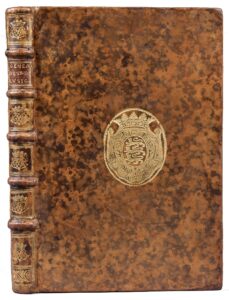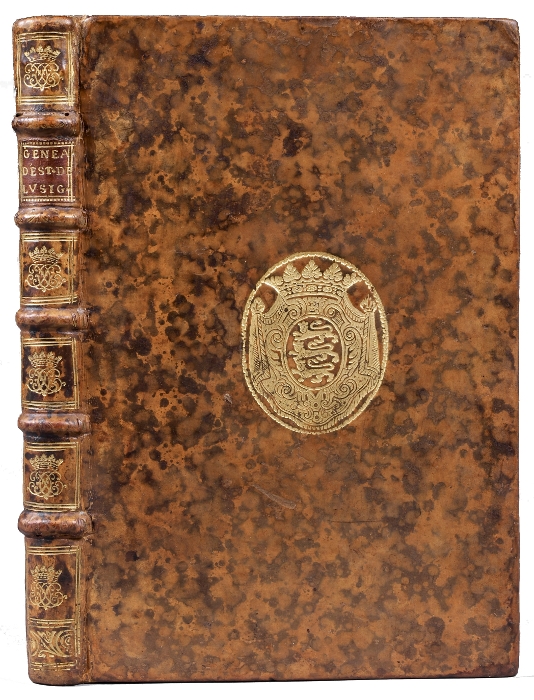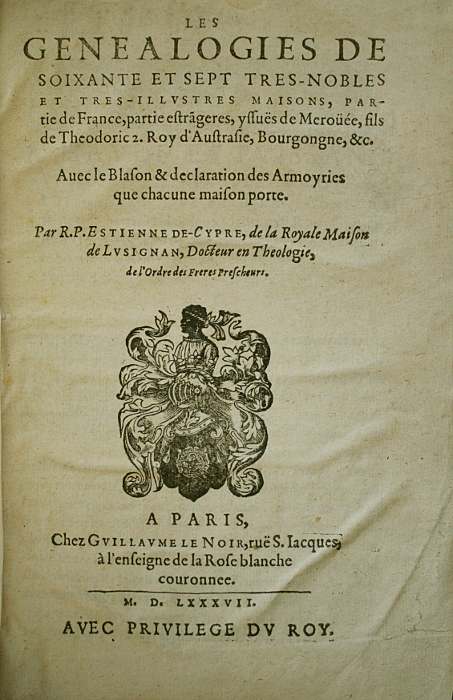Paris, Guillaume Le Noir, 1587.
[Following:] Paris, Guillaume Le Noir, 1586.
4to [225 x 150 mm] of: I/ (1) bl.l., (4) ll. for the title, the epistle and the table, 128 ll.; II/ (8) ll. for the title, the foreword and the table, 40 ll., (1) bl.l. Restoration at the right lower corner of the first leaf. Bound in full marbled calf from the end of the 17th century, arms stamped in gilt in the centre of the covers, spine ribbed and decorated with a crowned cipher repeated in the panels, red morocco lettering-piece, mottled edges.
I/ Interesting genealogical study conducted in the 16th century by the Greek historian Etienne de Chypre on the origins of his family. Brunet, III, 1239.
Etienne de Lusignan, who doesn’t hide his disdain for the legends related to the origins of his family, proposes to find its source far before Melusine, who he places only at the eleventh generation.
« The word “genealogist” appears in the French language in the middle of the 17th century, and not less than 130 legendary and historical genealogies have been published, according to Lenglet de Fresnoy, during the first modernity in France… The nobility appreciates these genealogies which maintain the cult of lineage, as much as the heraldry. This massive but ambivalent use of the research of ancestors led the historians to search its meaning. For a long time we saw in this genealogical infatuation a material and recognition crisis of nobility, today strongly protested. Competed with the ascent of officers, discredited during the religious wars, finally unable to appear as holder of virtue, the great nobility would carry out with the participation of the monarchy a social jamming withdrawing into its rank… Like the Dominican Étienne de Chypre emphasizes, the function of these genealogies for the families is to ‘show themselves as being from time immemorial’. » (J.-M. Le Gall, Vieux saint et grande noblesse à l’époque moderne: Saint-Denis, les Montmorency et les Guise, Revue d’histoire moderne et contemporaine).
The Lusignans were a feudal dynasty from the Poitou, maybe related to the one of the Lusignans from the Agenais, which became famous with the legend of Melusine. We don’t know well the origin, and its continuation is sure only from the 10th century (towards 967). We name: Hugues IV, called le Brun (until towards 1030); Hugues V, treacherously killed in 1080, Hughes VI, called the Devil, who takes part in the first crusade, Hugues VII who follows Louis VII to the East, finally Hugues VIII, from whom the counts de la Marche and d’Angouleme are descendents on the first hand, and on the other hand the kings of Cyprus and Jerusalem are also descendents, and by these latter, the Lusignans of the Armenian Kingdom of Cicilia.
The dedication of the present work is addressed to François de Luxembourg, Duc de Piney. The first text is illustrated at the verso of the table with a beautiful full-page woodcut showing Melusine carrying the coat-of-arms of the Lusignans, kings of Jerusalem, Cyprus, Armenia and of the Luxembourgs, emperor kings of Bohemia and Hungary.
II/ Rare first edition of the second text, in which Lusignan lists the various pretenders to the title, to the crown and the possession of the kingdom of Jerusalem.
« Etienne de Lusignan is a Greek historian born in 1537 in Nicosia (on the island of Cyprus), dead in 1590. He took holy orders of Saint Dominic, and changed his Christian name at this moment from Jacques to Etienne. In 1570 he came to Rome, and as the island of Cyprus was invaded by the Turks the following year, he stayed a while in Naples, from where he went to Paris in 1577. He lived ten years in this city. On April 27th 1578 the Pope Sixtus V appointed him bishop incumbent of Limassol. » (Biographie générale, 31, 278)
A precious copy bound with the arms and cipher of Henri-Jacques-Nompar de Caumont, duc de la Force, peer of France, born on March 5th 1675, dead on July 22nd 1726. « He was kidnapped from his parents who were Protestants in order to be raised in the college of the Jesuits; he even became an ardent persecutor of the Protestants in Saintonge and in Guyenne, when appointed colonel of a regiment; when his father died in 1699, the duc de Caumont inherited the title of duc de la Force and of the high position of peer of France; appointed member at the Académie Française on January 18th 1715, appointed vice-president of the council of finance in 1716, then member of the council of regency, he promoted the adoption of Law’s system. He died in July 1726. He married Anne-Marie de Beuzelin de Bosmelet on June 18th 1698, with who he had no child. » (Olivier, planche 1726; Guigard, Armorial du Bibliophile, 120-121)



